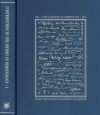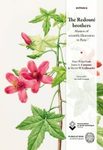""This is the final volume in the series" of three volumes (p. 2). Volume 1 (Sep. 1989) treated 152 herpetologists, whereas volume 2 (July 2007) featured 285. Volume 3 (Aug. 2012) covers 349 herpetologists for a total of 786 individuals, all deceased. Death is the ultimate price of admission for full biographees to this admirable necrology. There are also associated persons mentioned in passing, and "mini-biographies" for persons lacking "full biographies in the entire series" (p. 9). The period covered extends from the present back to circa 150 B.C. (see below). A large number of herpetologists died from the venom of their subjects. Herpetology most be the most hazardous field in the biological sciences, a field perhaps as dangerous as crop-dusting is in agriculture.
I quote from the website for the next three paragraphs (my insertions are in brackets):
This book consists of three sections [see also heading], each worldwide in coverage. The first and longest section ["Herpetologists of the past, part 3," pp. 8–386], by Kraig Adler, is a series of new biographies of the leading contributors to herpetology beginning with the author of the oldest surviving book on the subject, Nicander of Colophon of the second century B.C.E. The accounts [mostly] have a portrait, signature, and references. These feature 349 herpetologists and also include information about their colleagues, students, and many other persons. The comprehensive index encompasses volumes 1 to 3 and covers nearly 5,000 individuals. The book contains 197 additional full biographies plus 180 mini-biographies.
The second section ["Index of authors in taxonomic herpetology, third edition," pp. 387–469], by John S. Applegarth, is an index of 5,290 authors [some still alive] in taxonomic herpetology. This alphabetical list includes the full names, dates, countries of residence, and orders of taxa for everyone who has proposed a new taxon (genus or below) or has had a taxon named in their honor. This is a unique resource for zoologists, historians, and librarians. In five years (since the 2007 edition), the number of persons covered has increased by nearly 50 percent and many previously incomplete entries are now made whole.
The third section ["Academic lineages of doctoral degrees in herpetology, third edition," pp. 471–564], by Ronald Altig, is a listing of herpetologists giving the names of their doctoral university, their major professor, and the date of their degree. This extensive revision is 57 percent longer than the second edition of 2007. The information is arranged in such a manner that the academic lineages can be followed from generation to generation, both forward and backward in time. 5,562 names [1752 new, for 1745–2012, for 58 countries] are included and fully indexed.
Three volumes comprise the series. The index and general bibliography in section 1 and the entire sections 2 and 3 in volume 3 (2012) supersede their counterparts in volumes 1 (1989) and 2 (2007). For volumes 1 and 2 only the biographies are now relevant. Volume 1 is out of print and thus has only the biographies available online [...].
Joe Ewan and Larry Dorr, who reviewed volumes 1 and 2 (respectively, in Taxon 40: 151, 57: 1033–1034), emphasized the significance to botany of this herpetological series. Dorr counted "at least 75 [of the 285] persons treated [in volume 2] had a significant interest in botany." A quick scan of the 349 biographies in volume 3 yielded the following persons with appreciable interests in the plant sciences (the sequencing is Adler's): P. Kalm (1716–79), D. Vandelli (1735 –1816), M. Houtt uyn (1720 – 98), J.R. Forster (1729–98) and his son J.G.A. (1754–94), L. Bosc (1759–1828), H.F. Link (1767–1851), C.F. Meisner (1800 –74), J.C. Mikan (1769–1844), G. Raddi (1770–1829), W. Hemprich (1796–1825) and C.G. Ehrenberg (1795–1876) – see below, I. Frivaldszky (1799 –1870), C. Gay (1800 –73), W. Ferguson (1820 –87), E. Thurston (1855 –1935), H. Garman (1858–1944), H.A. Longman (1880– 1854), V.A. Wager (1904–89), G.A.C. Herklots (1902–86), and P.S. Martin (1928–2010).
Many of the early individuals discussed in the series were physicians, generalists, naturalists, explorers, disciples of Linnaeus, etc. Their courting of amphibians and reptiles inevitably also concerned plants, or less often vice versa. Later herpetologists were biogeographers, ecologists, conservationists, and environmentalists. In recent times herpetologists became more focused on their animals and less interdisciplinary or botanically inclined. This statement probably also applies to botanists and the zoological counterpart.
Adler, of course, gives considerable, usually very detailed biographical information. This is frequently admirably woven into "a broader historical context, including political, religious, and military events that had an impact on the work of the biographees" (p. 9). Take, for instance, the 19-paragraph account (pp. 66–69) for Wilhelm Hemprich (1796–1825) and Christian Gottfried Ehrenberg (1795–1876) [...]
[paragraph 1] The University of Berlin, the first modern research-intensive university, was founded in 1810. It soon established a zoological museum (today's Museum für Naturkunde) that came to be directed by the zoologist, Hinrich Lichtenstein, in 1813. His ambition was to build it into a rival of the British Museum in London and the Muséum d'Histoire Maturelle in Paris. ... In the style of Carl Linnaeus before him, Lichtenstein encouraged his former students and others associated with the university to travel overseas and make collections for the museum. ... Among them were two of his former students Wilhelm Hemprich and C.G. Ehrenberg, who traveled to Egypt, Nubia, Arabia, and Lebanon during 1820–1825.
[paragraphs 2–4 on background of Hemprich and Ehrenberg deleted]
[paragraph 5] This was an era when many young German men, inspired by the natural history explorations of Baron Alexander von Humboldt and Prince Maximilian zu Wied-Neuwied in South America, actively sought their own opportunities for glory. Hemprich and Ehrenberg, with Lichtenstein's active encouragement, were soon presented with an opening when the Prussian general, Baron Heinrich Menu von Minutoli, planned an archeological expedition to Egypt. Humboldt, then still living in Paris, and Lichtenstein recommended to the Prussian government that Hemprich and Ehrenberg be sponsored to accompany this party, in order to make natural history observations and collections. Earlier naturalists had visited the general region, including two of Linnaeus's students, Frederic Hasselquist and Pehr Forsskål, as well as Étienne Geoffroy Saint-Hilaire, who accompanied Napoleon Bonaparte in the French conquest of Egypt. None of them, however, had penetrated Egypt very deeply or had reached the Abyssinian Highlands (in today's Ethiopia) where the Scottish explorer, James Bruce, claimed to discover the source of the Blue Nile in November 1770. Upper Egypt and the Abyssinian Highlands thus became Hemprich and Ehrenberg's primary goals.
[paragraph 6] The Ottoman Empire, however, was then consolidating its rule of Egypt. Muhammad Ali, a Turk born in Macedonia, had deposed the pasha of Egypt in 1805, and by the summer of 1820 had begun a campaign to conquer the Nile Valley from the Mediterranean to Abyssinia. It was a violent campaign in which some 50,000 Sudanese died. Entire towns were burned and the inhabitants massacred, and 3,000 human ears were sent back to Ali in Cairo as evidence of his army's work. Because Khartoum (in present-day Sudan) was not taken by Turkish troops until 1824, the entire Nile Valley was then in continuous, unpredictable warfare. Such was the unsettled situation faced by the two naturalists.
[paragraphs 7–11 on activities of Hemprich and Ehrenberg deleted]
[end of paragraph 12] ... By the end of their five-year long expedition [Aug. 1820–Nov. 1825], nine members of the party including Hemprich had died.
[paragraph 13] The material results of the expedition were enormous: 46,000 plant specimens (about 3,000 species) and 34,000 animals (more than 4,000 species). Hemprich and Ehrenberg labeled each specimen as to its precise locality and date. Unfortunately, the integrity of their collection and its documentation was in jeopardy long before Ehrenberg returned to Berlin. ...
[paragraphs 14–18 on collections of Hemprich and Ehren- berg plus paragraph 19 (bibliography and two notes) deleted]
Section 3 on "academic lineages of doctoral degrees" has some fascinating information worth quoting in full (p. 472, URLs accessed 9 Jan. 2013):
... Louis Agassiz, via [Lorenz] Oken [(1779–1851)], had 1461 descendants involving 273 major professors, an average of about 5.3 students per professor, over 182 years. W.F. Blair (US couplet 1.46) from the University of Texas at Austin had the largest number (39) of herpetological students, and at least 17 others had 20 or more such students; many of these also had non-herpetological students. As a comparison, the genealogy of mathematicians [Anonymous. Mathematics Genealogy Project. http://genealogy.math.ndsu.nodak.edu] has over 151,610 entries [167,250 as of 9 Jan. 2013] from the 1400's to present, and some individuals have over 82,000 descendants; a sample genealogy of one terminal person from this data set in a tree format appears in Wired magazine (June 2011: 56). An exhaustive analysis of the math genealogy [R.D. Malmgren & al., 2010, The role of mentorship in protégé performance, Nature 465: 622–627] found correlations between mentor and protégé success that varied through time. One has to ask what patterns might be hiding in the herpetological lineage? There is a genealogy of evolutionary biologists at http://academictree.org/evolution/ and this includes a number of herpetologists. Similar genealogical data on chemists and physicists can be found at http://www.careerchem.com/NAMED/Genealogy-List.pdf [("Scientific genealogy master list") and at http:// www.careerchem.com/NAMED/Genealogy-Trees.html ("Genealogy trees")].
Botany is renowned for its rich bibliographic and biographical literature, as exemplified by F.A. Stafleu's & al.'s seven-volume Taxonomic Literature, 2nd edition (1976–88), and the eight-volume supplement (1992–2009) to its volume 1 (for review see R. Schmid & L.J. Dorr, Taxon 58: 689–691), as well as the "History, biography, and bibliography" section of the RevNot column. However, I am unaware of any works on genealogical lineages of botanists collectively. Botanists could use such a work to be on par with their herpetological counterparts.
This three-volume series is an outstanding and important resource, not only for herpetology but also for all areas of biology. Herpetologists and bibliophiles in other areas should be greatly indebted to Ronald Altig, John Applegarth, and especially Kraig Adler. [At $75.00, this large format, copiously illustrated, 571-page book is a tremendous bargain; only 2950 copies were printed. A digital version (CD-ROM or e-book) of the series would be invaluable.]"
- Rudolf Schmid, University of California, Berkeley, Taxon 62(1), February 2013, 199-200






















![Die Vogel-WG: Die Heinroths, ihre 1000 Vögel und die Anfänge der Verhaltensforschung [The Bird Wohngemeinschaft: The Heinroths, Their 1000 Birds and the Beginnings of Behavioral Research]](http://mediacdn.nhbs.com/jackets/jackets_resizer_medium/26/267983.jpg?height=150&width=107)








![Erpétologie Générale ou Histoire Naturelle Complète des Reptiles [General Herpetology or Complete Natural History of Reptiles] (6-Volume Set)](http://mediacdn.nhbs.com/jackets/jackets_resizer_medium/20/203973.png?height=150&width=207)



![Snakes of the Agkistrodon Complex: A Monographic Review [Plate Section Only]](http://mediacdn.nhbs.com/jackets/jackets_resizer_medium/73/7352.jpg?height=150&width=115)

